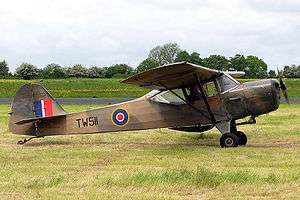No. 664 Squadron RAF
| No. 664 Squadron RAF | |
|---|---|
| Active |
9 December 1944–31 May 1946 1 September 1949 – 10 March 1957 |
| Country |
|
| Branch |
|
| Type | Inactive |
| Role | Air Observation Post squadron |
| Part of | Royal Auxiliary Air Force |
| Motto(s) |
Latin: Vae Viso ("I espied it; woe betide it")[1] |
| Insignia | |
| Squadron Badge heraldry | Badge: An archer kneeling in a sinister position, his bow fully drawn[1] |
| Squadron Codes |
AW (Dec 1944 – May 1946)[2] [3]ROD (Sep 1949 – Apr 1951)[4][5] |
| Aircraft flown | |
| Reconnaissance | Auster Single-engined Army liaison monoplane |
No. 664 Squadron was a Royal Air Force Air Observation Post squadron associated with the Canadian 1st Army and later part of the Royal Auxiliary Air Force. Numbers 651 to 663 Squadrons of the RAF were Air Observation Post units working closely with Army units in artillery spotting and liaison. A further three of these squadrons, 664–666, were manned with Canadian personnel. Their duties and squadron numbers were transferred to the Army with the formation of the Army Air Corps on 1 September 1957.[6][7]
History
Formation and World War II
No. 664 Squadron was formed on 9 December 1944 at RAF Andover as an air observation post (AOP) squadron associated with the Canadian 1st Army. The pilots were officers recruited from the Royal Canadian Artillery and trained to fly at 22 E.F.T.S. Cambridge, further developing advanced flying skills at 43 Operational Training Unit RAF (43 OTU), RAF Andover. The first Commanding Officer was Major Dave Ely, RCA; the operational Commanding Officer was Major D.W. Blyth, RCA. In England the squadron operated under the overall control of No. 70 Group, RAF Fighter Command; prior to deployment to the European continent, the squadron was transferred to No. 84 Group, Second Tactical Air Force (2 TAF). In January 1945, the squadron was deployed to RAF Penshurst, deploying to the Netherlands in March 1945.[8] The squadron flew its first operational sortie over the enemy front in the Netherlands on 22 March 1945. The principal aircraft flown in action was the Taylorcraft Auster Mk. IV and V. After V-E Day on 8 May 1945, the squadron was tasked with flying mail and passengers for 1st Canadian Army. The squadron continued flying like duties for the Canadian Army Occupation Force (CAOF) until the spring of 1946. 664 (AOP) Squadron, RCAF, was disbanded on 31 May 1946 at Rostrup, Denmark.[1][9] Although the squadron's trained aircrew observers performed yeoman service in aerial action against the enemy, aircrew associations across Canada did not grant membership to AOP observers, as those aircrew were not officially issued with cloth wings during the war[10]
Post-war
As the number was not transferred to the Canadian authorities, it was revived post-war when the squadron was reformed as part of the RAuxAF on 1 September 1949 at RAF Hucknall. Equipped with Auster aircraft, the squadron was based at RAF Hucknall (1970 (Reserve) AOP Flight), with other detached flights at RAF Ouston (later at RAF Usworth 1965 (Reserve) AOP Flight), RAF Desford (later at RAF Wymeswold 1969 (Reserve) AOP Flight) and Yeadon Aerodrome (also at RAF Rufforth 1964 (Reserve) AOP Flight),[11] before it was disbanded, like all other units of the Royal Auxiliary Air Force, on 10 March 1957.[9]
Present
The original squadron is represented today by 664 Squadron of 4 Regiment, Army Air Corps
Aircraft operated

| From | To | Aircraft | Variant |
|---|---|---|---|
| December 1944 | May 1946 | Auster | Mk.IV |
| December 1944 | May 1946 | Auster | Mk.V |
| September 1949 | October 1951 | Auster | AOP.5 |
| September 1949 | February 1957 | Auster | AOP.6 |
See also
References
Notes
- 1 2 3 4 Halley 1988, p. 447.
- ↑ Flintham and Thomas 2003, p. 63.
- ↑ Barrass, M. B. (2015). "No. 651–670 Squadron Histories". Air of Authority - A History of RAF Organisation. Retrieved 13 October 2015.
- ↑ Bowyer and Rawlings 1979, p. 138.
- ↑ Flintham and Thomas 2003, p. 187.
- ↑ Halley 1988, pp. 444–451.
- ↑ Jefford 2001, pp. 102–105.
- ↑ "Leigh in the War, 1939–45" (PDF). Leigh and District Historical Society. September 1993. Retrieved 13 January 2010.
- 1 2 3 Jefford 2001, p. 105.
- ↑ "Membership Eligibility-Toronto Aircrew Association". Toronto Aircrew Association. 11 November 2008. Retrieved 11 November 2008.
- ↑ Sturtivant and Hamlin 2007, p. 131.
Bibliography
- Blackburn, George. Where The Hell are the Guns?, Toronto, Canada: McClelland & Stewart Publishing, 1997. ISBN 0-7710-1504-6.
- Bowyer, Michael J.F. and John D.R. Rawlings. Squadron Codes, 1937–56. Cambridge, UK: Patrick Stephens Ltd., 1979. ISBN 0-85059-364-6.
- Flintham, Vic and Andrew Thomas. Combat Codes: A full explanation and listing of British, Commonwealth and Allied air force unit codes since 1938. Shrewsbury, Shropshire, UK: Airlife Publishing Ltd., 2003. ISBN 1-84037-281-8.
- Fromow, Lt-Col. D.L. Canada's Flying Gunners: A History of the Air Observation Post of the Royal Regiment of Canadian Artillery. Ottawa, Canada: Air Observation Post Pilots Association, 2002. ISBN 0-9730055-0-5.
- Halley, James J. The Squadrons of the Royal Air Force & Commonwealth, 1918–88. Tonbridge, Kent, UK: Air-Britain (Historians) Ltd., 1988. ISBN 0-85130-164-9.
- Jefford, Wing Commander C.G., MBE,BA,RAF (Retd). RAF Squadrons, a Comprehensive Record of the Movement and Equipment of all RAF Squadrons and their Antecedents since 1912. Shrewsbury, Shropshire, UK: Airlife Publishing, 2001. ISBN 1-84037-141-2.
- Rawlings, John D.R. Coastal, Support and Special Squadrons of the RAF and their Aircraft. London: Jane's Publishing Company Ltd., 1982. ISBN 0-7106-0187-5.
- Stewart, Major A.B. Battle History 666. Epe, the Netherlands, 1945. Republished by Abel Book Company, Calgary, 2006.
- Sturtivant, Ray, ISO and John Hamlin. RAF Flying Training And Support Units since 1912. Tonbridge, Kent, UK: Air-Britain (Historians) Ltd., 2007. ISBN 0-85130-365-X.
- Library and Archives Canada – Reel #C12430. War Diary of 664(AOP)(RCAF) Squadron.
